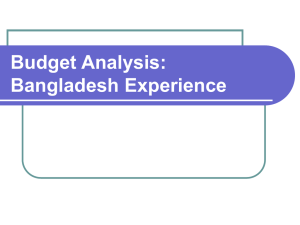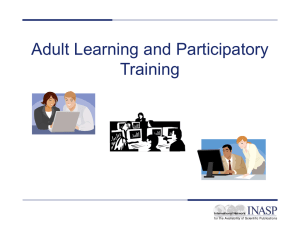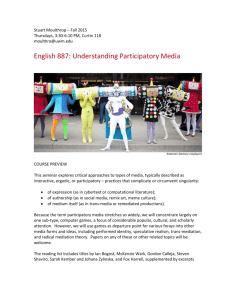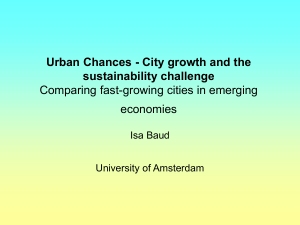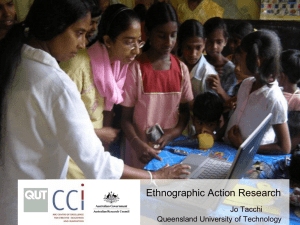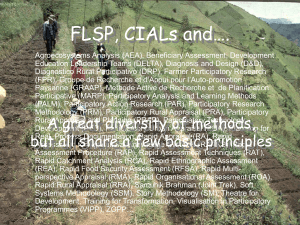Improving children`s participation in collecting and disseminating
advertisement
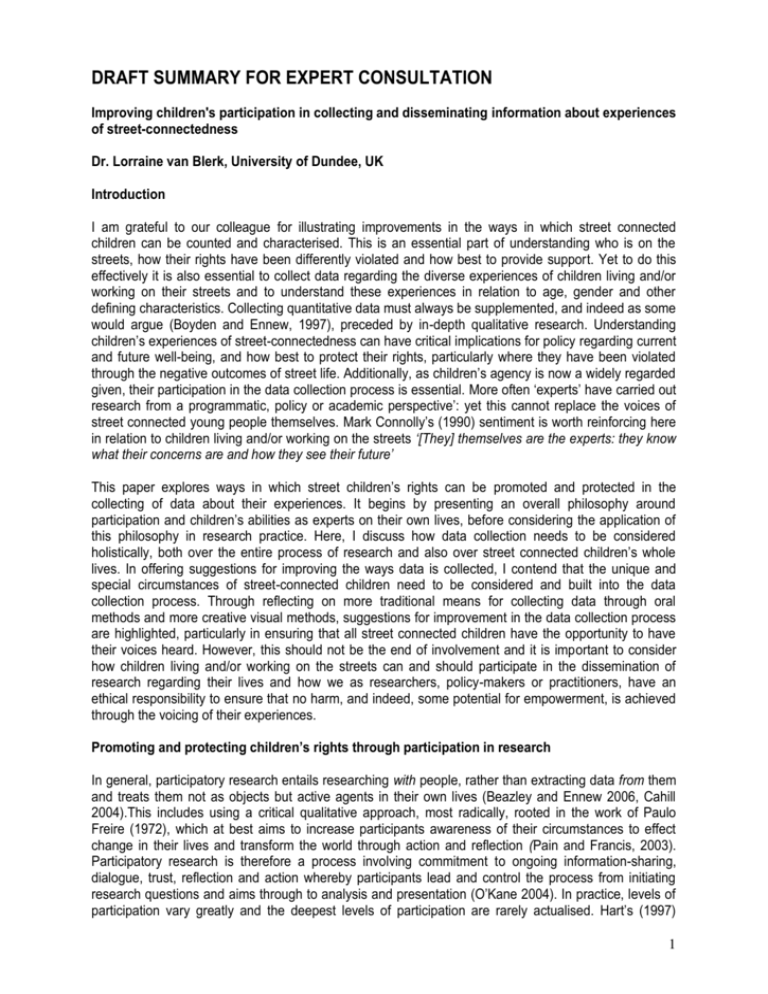
DRAFT SUMMARY FOR EXPERT CONSULTATION Improving children's participation in collecting and disseminating information about experiences of street-connectedness Dr. Lorraine van Blerk, University of Dundee, UK Introduction I am grateful to our colleague for illustrating improvements in the ways in which street connected children can be counted and characterised. This is an essential part of understanding who is on the streets, how their rights have been differently violated and how best to provide support. Yet to do this effectively it is also essential to collect data regarding the diverse experiences of children living and/or working on their streets and to understand these experiences in relation to age, gender and other defining characteristics. Collecting quantitative data must always be supplemented, and indeed as some would argue (Boyden and Ennew, 1997), preceded by in-depth qualitative research. Understanding children’s experiences of street-connectedness can have critical implications for policy regarding current and future well-being, and how best to protect their rights, particularly where they have been violated through the negative outcomes of street life. Additionally, as children’s agency is now a widely regarded given, their participation in the data collection process is essential. More often ‘experts’ have carried out research from a programmatic, policy or academic perspective’: yet this cannot replace the voices of street connected young people themselves. Mark Connolly’s (1990) sentiment is worth reinforcing here in relation to children living and/or working on the streets ‘[They] themselves are the experts: they know what their concerns are and how they see their future’ This paper explores ways in which street children’s rights can be promoted and protected in the collecting of data about their experiences. It begins by presenting an overall philosophy around participation and children’s abilities as experts on their own lives, before considering the application of this philosophy in research practice. Here, I discuss how data collection needs to be considered holistically, both over the entire process of research and also over street connected children’s whole lives. In offering suggestions for improving the ways data is collected, I contend that the unique and special circumstances of street-connected children need to be considered and built into the data collection process. Through reflecting on more traditional means for collecting data through oral methods and more creative visual methods, suggestions for improvement in the data collection process are highlighted, particularly in ensuring that all street connected children have the opportunity to have their voices heard. However, this should not be the end of involvement and it is important to consider how children living and/or working on the streets can and should participate in the dissemination of research regarding their lives and how we as researchers, policy-makers or practitioners, have an ethical responsibility to ensure that no harm, and indeed, some potential for empowerment, is achieved through the voicing of their experiences. Promoting and protecting children’s rights through participation in research In general, participatory research entails researching with people, rather than extracting data from them and treats them not as objects but active agents in their own lives (Beazley and Ennew 2006, Cahill 2004).This includes using a critical qualitative approach, most radically, rooted in the work of Paulo Freire (1972), which at best aims to increase participants awareness of their circumstances to effect change in their lives and transform the world through action and reflection (Pain and Francis, 2003). Participatory research is therefore a process involving commitment to ongoing information-sharing, dialogue, trust, reflection and action whereby participants lead and control the process from initiating research questions and aims through to analysis and presentation (O’Kane 2004). In practice, levels of participation vary greatly and the deepest levels of participation are rarely actualised. Hart’s (1997) 1 ‘ladder of participation’ describes a spectrum of ways of involving young people, and although the most basic may be tokenistic and even exploitative, participation at the highest level is not always considered universally desirable. Indeed, participants might not desire full participation; hence it is most appropriate to work with children on their own terms (Kindon et al 2007). However, engaging in data collection without significant discussion with children of all aspects of the research process (aims, methods, level of involvement, dissemination etc) has been widely criticised and must be avoided (Boyden and Ennew, 1997). Participatory research is also associated with particular methods such as visual methods where produced images become the focus for discussion and collective analysis. However, it is not the methods themselves that make the research participatory, but rather the way data is produced through the social relations that take place between participants and researchers both in the data production and analysis. Those researching with street connected children advocate participatory approaches, for both ethical and practical reasons. Participatory techniques are understood to shift power relations, giving children greater control over their involvement in the research. Moreover, children’s insights into their own lives are said to be most readily expressed when they are facilitated through self-directed methods (Young and Barrett 2001a). Different children prefer or require different methods (Punch 2002) so a multi-method approach enables most to contribute (Morrow 2008), and seeks to include the experiences of the hardest to reach groups, usually those whose rights have been violated the most. Participatory research is also likely to retain children’s interests, enhancing the richness of the information they provide. Improving methods to promote and protect the rights of children living and/or working on the streets Against the backdrop of such a participatory philosophy, there are additional considerations that are required in order to most effectively improve the ways in which data is collected about street connected children’s experiences. Taking a relational perspective Taking a relational perspective to children’s street connected experiences is important as they interact with, and engage in social relations with a variety of actors in their lives. Therefore the data collection process regarding experiences of the street must not consider children in isolation. Even when seeking their views is the priority, we need to remember that they’re integral to families, communities and nations. They’re not simply divorced from contact with adults and peers. An approach that takes this into account will try to understand street connectedness more holistically. There is currently little research that integrates children’s actual experiences with the relational and contextual background to these experiences. Data collection that seeks to promote and protect children’s rights must explore who are the significant others in their relationship network and how they interact with them. This must also include those working at policy and practical levels to ensure that children’s needs are being appropriately addressed. Using participatory visual methods that bring together different actors in collective discussion with street connected children about their experience could provide a rich source of information. Researching across the lifecourse There is also little data regarding children’s experiences over the lifecourse and if data is to be used to effectively support children living and/or working on the streets, we cannot confine the data collection process to the timing of their being on the streets. Much can be gained from understanding what happens to street connected children as they grow up, and how their needs change, as well as understanding how early childhood experiences impact on street connectedness and the ways in which 2 prevention strategies can be better implemented. To this end multiple methods tailored to the ages and stages of children over the lifecourse could enrich our understanding of the before and after of street connectedness and foster opportunities for the development of specific prevention and post-childhood interventions. Considering the special circumstances of street connectedness In order to ensure we protect the rights of children living and/or working on the streets through the means by which data collection is undertaken with them, it is necessary to consider the special circumstances that many such young people are faced with. Sibley’s (1991) statement that “appropriate research strategies, in both methodological and ethical senses need to be through very carefully” (p. 270), is especially pertinent for street connected children. This means that because children are active participants throughout the research process and their agency recognised, we should not overlook the complex ways in which their lives are shaped by events and situations beyond their control (Holloway and Valentine, 2000). The numerous ways in which street life affects children’s abilities to engage in particular types of data collection should be carefully considered. Rather than suggesting that we select methods for data collection that are ‘special methods for children’, the aim here is to tailor methods that could be used for anyone (Punch, 2002), but that are adapted to the particular needs and abilities of street-connected children. As we have heard over the course of this meeting, street children’s lives are complex and varied and it is essential to note that children’s right to have their voice heard provides us with a obligation to ensure the data collection process enables them to do that. For instance, factors such as drug use, which can reduce attention span and focus which may exclude certain methods that require long periods of concentration, while illiteracy or poor literacy and numeracy levels may make other forms of written data collection more difficult. In addition, negative relationships with authority figures; lack of trust of unfamiliar adults may make some methods such as one to one interviews intimidating. Hunger, lack of sleep, lack of available time, loss of earnings, and mobility are also issues, which require careful integration into the ways in which street-connected children engage in data collection. The timing and placing of data collection must therefore be on their terms. This may involve working at a variety of times and places in order to suit the needs of children, their daily work patterns and levels of mobility. For instance some children may spend time in different towns or parts of the city on different days and this should be accounted for, so as not to exclude them. Further, gender is an important consideration particularly where girls may find that they are severely restricted in their freedom to spend time engaged in research. In some work I undertook in Ethiopia, girls engaged in commercial sex work were subject to varying working patterns with those located in red-light districts had their time highly structured and found it very difficult to spend time outside their employment. However remembering the context to street-connected children’s situation and the relationships they are part of can be helpful in negotiating time to participate in data collection when it is convenient for all parties. In choosing methods of data collection it is also worth considering whether it is necessary to generate a series of individual accounts or collective accounts that draw on a range of young people’s experiences to provide generalised rather than specific information about street experiences. The former uses interview-based material, such as the collection of narratives or life histories and is particularly useful when dealing with sensitive information. However, many of the concerns around using in-depth traditional methods such as this can advocate for young people to work together in the production of collective accounts generated through participatory activities. Through working from a perspective of respect for children, I suggest some possibilities for improving the data collection process, through a mixed method approach that utilises traditional methods and more innovative, creative and often collective ways of collecting information about street experiences. 3 Exploring new possibilities for doing research using traditional methods A key criticism of using traditional social science research methods such as questionnaires and interviews with children is that they ignore the imbalance of power relations between children and adults, and in fact reinforce these. This is pertinent to street –connected children who may have experienced particular negative relationships with adults and suffered through the abuse of such powerful relationships. In order to protect the rights of such children it is essential to overcome such imbalances and take the lead from young people themselves (Young and Barrett, 2001a). Trust is an essential part of this process and therefore training street and social workers, who have already developed trust-based relationships, in interview techniques and ethical and child protection measures, can be supportive. Ensuring the confidentiality of all information and anonymity for participants is also an essential part of building trust. In certain contexts, it may be possible to work with street connected young people in a participatory manner by which they receive training in data collection and conduct their own interviews and discussions. Exploring possibilities for children interviewing each other can also be empowering both for those acting as interviewer and as expert. One such example is through radio interviews, whereby role play scenarios are put in place with one child interviewing another as an expert on street life. A tape recorder is used as a microphone for later transcription of the discussion. Similar strategies can be used in focus groups where facilitators take a back seat enabling the children to take turns at facilitating the discussion by being in control of the tape recorder. Porter et al (2009) and others have utilised children as researchers effectively in other contexts and this can offer empowerment through improvements in feelings of self-worth and the acquisition of new skills. Additionally, where information is particularly sensitive, children may be more comfortable engaging in monologues with a tape recorder, or talking to their peers, who are already aware of the sensitivities or violation of rights that has occurred. In such instances, it is imperative to ensure confidentiality and train young interviewers accordingly. Using visual methods to improve data collection In addition to oral interview data, visual methods are useful for exploring children’s experiences of street connectedness. While written methods are often not appropriate for some street-connected young people who may have little or no experience of formal schooling. Visual methods, such as producing maps, pictures, and photographs are generally participatory activities that can be empowering for young people as they take control of the process of data collection, generally without the need for adult involvement. Similarly, the use of visual methods breaks down literacy barriers and allows for gender and age differences to emerge in collective accounts. For instance, where young people compare maps or photographs of important places in their discussions more nuanced accounts can be made. Visual methods further enable participation in the analysis of research materials as they can be used to elicit oral description, in fact a necessary component. Through engaging in oral description, with the maps, drawings or photographs forming a focal point, a basic level of analysis is undertaken. The meaning behind images can be sought along with an understanding of why they form an important part of street experience. Used in this way, as supplementary to collecting narratives or interview data, visual methods also help to focus stories regarding experiences. Drawing maps of important places, engaging in self-directed photography over a period of time such as a day or a week, can be conducted individually or between groups of friends. This allows for the temporality of street experience to be captured as these visual prompts elict discussion about events that took place some time ago. Further, where children are likely to have low attention spans, or where their ability to focus on a task is diminished, visual prompts, for instance in the form of photographs they have taken over a day or a week, can help to trigger memories of important aspects of street experiences. 4 Promoting and protecting children’s rights at the end of the research process Tailoring methods to include children’s voices in the data collection process, it is essential not to forget that street-connected children also have the right to have their voices heard throughout the whole research process from start to finish. A neglected aspect is the disseminating of data and what happens next. It is this final area that I want to turn to now. Feedback and dissemination A crucial aspect to ensuring street-connected children’s voices are part of the whole research process is through their involvement in the analysis and dissemination of research findings. Although it is important to feedback results of research, and to be open and honest regarding how such information will be used for the betterment of their lives and others in similar situations, promoting their voices through involvement in dissemination is also important. By engaging in an active dissemination process with street connected children (van Blerk and Ansell, 2007) the findings of research will be enhanced and research will be able to promote their voices more effectively. There are two stages to this active dissemination process: First, this means that the analysis process should be a dialogue between those who have undertaken the research and those who have participated, providing opportunities for young people to comment on the findings. There are various methods that can be employed and these include, but are not limited to the following ideas. Open discussion around the findings, and the researchers interpretation of the findings, can have significant value. Here, children can comment on whether what has emerged in the results as important aspects of their lives is actually the case, and they can include any missing issues or omit less important issues. A further option would be to undertake ranking exercises where children are given the findings on paper or in pictures and asked how they might order issues in their lives in terms of importance, at this stage it may also be appropriate to think through together how such issues could be rectified both by themselves in their own lives and through the support and help of others such as their immediate communities, Government, NGOs, police etc… Drama may be used in these contexts to encourage children to think about solutions to particular issues and who the actors involved might be. Producing drama in this way encourages thinking about the outcomes of research and how it could be used. Second, promoting the voices of street-connected children to others is an essential part of the process and one where their inclusion is pertinent. However, the question of scale is important here. At community level, it is important to disseminate to local audiences, who are actively engaged with the research participants, and can impact on their quality of life through how they treat street-connected children. Street-connected children can, and should be part of this process and it may be possible to explore with local communities through workshops or community meetings the problems faced through being on the streets and how their understanding can assist in developing potential solutions. This can be achieved through presentations of dramas or discussion of experiences as produced in open discussion or ranking exercises. However, it is often more difficult to promote the voices of street-connected children at a policy level without their inclusion being tokenistic. Through dissemination, it is necessary to ensure that participants have the opportunity to consider what should be fed into policy dialogue in terms of what is required to address their needs. Yet, it is important to choose strategies that young people will feel comfortable with as a means to represent their views (Valentine, 1999). Although an ideal scenario may be that street-connected children and policy-makers sit together to work through recommendations or the implementation of solutions that support their rights more effectively into policy, this can have severe limitations and without proper training can be a daunting and difficult prospect for young people. It is important not to produce situations where children are merely ‘on show’, uncomfortable in an unfamiliar context and expected to speak to a formidable audience. Under such conditions children’s participation 5 is heavily directed by adult researchers. To overcome this tension, presenting children’s ideas through video recordings of their drama or presentation of their analysis through posters can act as a means for expression and promotion of street-connected children’s voices in policy dialogue. Here they have had the opportunity to input into policy discussions within an environment where they feel comfortable and relaxed. Further, dramas and posters can provide a stimulus for discussion in policy dialogues around general issues without stigmatizing individuals through the presentation of personal stories. We have heard the voices of children at this meeting through Louise’s presentation yesterday, and this is a commendable step forward. However, where young people are not physically present in policy making arenas, they are unable to actively engage in dialogue with policymakers and therefore do not really form part of the wider discussion. This is clearly problematic and there is no easy solution. Yet, to offer an opportunity to further comment on the recommendations that emerge from this meeting would be a step forward in ensuring street-connected children’s voices have been included in the shaping of policy and practice. Debriefing and counselling Finally, in this paper I would like to respond to an area often neglected in the research process with street-connected children, that of the personal impact of exploring one’s experiences through participatory activities or through telling life stories and narratives. Ideologically and ethically those that engage in social and/or participatory research do so from particular theoretical and practical standpoints that encompass blurring the boundaries between action oriented research, activism and co-production of knowledge (mrs kinpaisby, 2008). Despite the ideological aim to address imbalances of power between the researched and researcher through participatory processes, the process of empowerment can be an uncomfortable space both for participants and researchers. In order to ensure that research does not violate young people’s rights and can in fact offer some empowerment through engaging in the process, appropriate debriefing is essential. This is particularly important when children have experienced traumatic events in their lives. This is more often the case when exploring street experiences, which have the potential to be emotionally harmful. Often the narratives presented by street-connected children will raise numerous concerns regarding life on the streets covering both negative issues in children’s personal lives and their involvement in illegal activities. In many instances this may be the first time they openly disclose such detailed information on their past and present lives. Despite the acknowledgement that the collecting of personal biographies can bring emotional issues to the surface coupled with the therapeutic properties of telling one’s life story (Robson 2001), the issue of what to do next is rarely discussed in research methodology literature, leaving little advice available, particularly where those undertaking research are not appropriately trained in counselling or coaching. Listening is both a skill of those engaged in social work and psychological professions and those carrying out social and/or participatory research, yet post-intervention counselling is well documented and hailed as good practice. Why is this not the case for post-research debriefing and counselling? To fully protect the rights of children in the collection of data, including their right to be happy, safe and protected, research should offer debriefing strategies to cope with emotional issues and subsequent follow-on counselling to deal with any resurfacing of past traumatic events. In turn this should have an empowering effect and offer some potential future self-improvement. For example, in research that involved the collection of biographical life history narratives from over 30 street youth in Cape Town the inclusion of a practitioner psychologist in the research, who could offer debriefing and follow-up counselling/life coaching resulting in improvements in self-confidence and self-worth among those that sought additional support (van Blerk, 2011). Conclusion In promoting and protecting the rights of children living and/or working on the streets in the process of data collection about their experiences of the street, I offer the following recommendations: 6 1. Promoting and protecting street connected children’s rights in data collection about their experiences should be undertaken from a participatory perspective, where children themselves are viewed as experts on their own lives and able to articulate their needs and experiences. 2. Improving the data collection process begins with researching the experiences of children living and/or working on the streets more holistically. This should include taking a relational perspective, and including others that are part of street connected children’s relational networks in the research. In addition, children’s lives need to be researched across the whole lifecourse to better provide prevention and post-childhood interventions. 3. The context of street life needs to be considered in the selection and adaptation of research methods, whether they are traditional oral methods or more creative visual methods, in order to access the views off the diverse range of street connected children. 4. Children need to be included at the end of the research process both through involvement in the analysis and dissemination of data and in policy dialogue to better support their rights. 5. Finally, debriefing and post-research counselling should be offered to all street connected children that offer their personal stories for data collection purposes to ensure that their rights are not violated through the process of research and that it has the potential to offer selfimprovement. References Beazley, H and Ennew, J 2006 Participatory methods and approaches: Tackling the two tyrannies. In V. Desai and R. Potter, eds, Doing Development Research London: Sage, 189-199. Boyden, J and Ennew, J 1997 Children in Focus – a manual for participatory action research with children, Radda Barnen, Swedish Save the Children, Stockholm. Cahill, C 2004 Defying gravity? Raising consciousness through collective research. Children’s Geographies, 2(2), 273-286 Freire, P. 1972. Pedagogy of the oppressed. Harmondsworth: Penguin Hart, R. 1997. Children's participation: the theory and practice of involving young citizens in community development and environmental care. London: Earthscan. Holloway, S and Valentine, G 2000 Children’s geographies,: playing, living, learning, Routledge, London. Kindon, S Pain, R and Kesby, M eds, 2007 Connecting People, Participation and Place: Participatory Action Research Approaches and Methods. London: Routledge. Morrow, V 2008 Ethical dilemmas in research with children and young people about their social environments. Children's Geographies, 6(1), 49-61 mrs kinpaisby, 2008 Boundary crossings: taking stock of participatory geographies: envisioning the communiversity, Transactions of the Institute of British Geographers, 33(3):292-299. O’Kane, C 2004 Responding to Key Challenges and Ethical Issues, in Children and Young People as Citizens: Partners for Social Change. Kathmandu: Save the Children Alliance Pain, R. and Francis, P 2003 Reflections on participatory research. Area, 35(1), 46-54 Punch S 2002 Research with children: the same or different form adults? Childhood, 9(3): 321-341. Robson, E 2001 Interviews worth the tears? Exploring dilemmas in research with young carers in Zimbabwe, Ethics, Place and Environment, 4(2):135-142. Sibley, D 1991 Children’s Geographies: some problems of representation, Area, 23:269-270. Valentine, G 1999 Being seen and heard? The ethical complexities of working with children and young people at home and at school, Ethics, Place and Environment, 2(2), 141–155. 7 van Blerk, L 2011 Researching street youth’s life paths in Cape Town, South Africa, Paper presented at the RGS-IBG International Conference, London, 1-3 September 2011. van Blerk, L and Ansell, N 2007 Participatory feedback and dissemination with and for children: reflections from research with young migrants in southern Africa’, Children’s Geographies, 5:(3):313-324 Young, L and Barrett, H 2001a ‘Issues of access and identity: Adapting research methods with Kampala street children’, Childhood: A Global Journal of Child Research, 8(3): 383-395. Young, L and Barrett, H 2001b ‘Adapting visual methods: action research with Kampala street children’, Area,33(2): 141-152. 8


